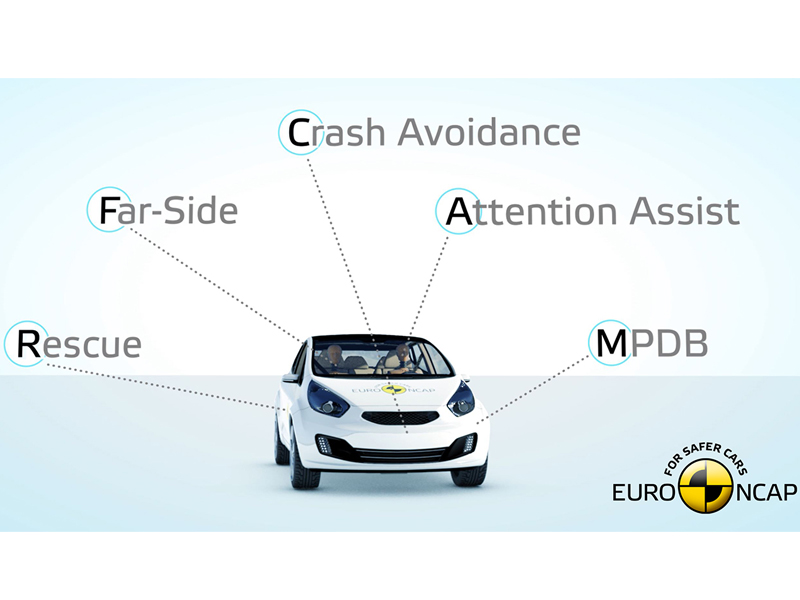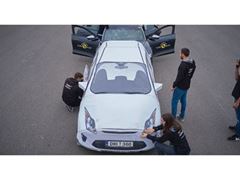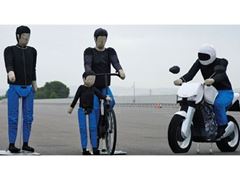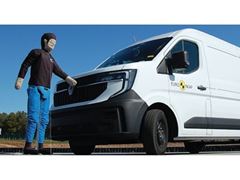-
20-MAY-2020
Leuven
Euro NCAP Presents Latest Overhaul of Its Safety Rating

Leuven, 20 May 2020
Every two years, the European New Car Assessment Programme updates and toughens its test protocols. This year new tests are introduced to address some long-standing needs in occupant protection, improve post-crash protection and promote the latest advanced driver assistance technology.
A key change is the implementation of a new moving barrier to moving car frontal crash test, replacing the regulation-based moderate offset-deformable barrier test, used by Euro NCAP for the last 23 years. This new crash test not only evaluates the protection of occupants inside the car, but also assesses how the cars’ front-end structurers contribute to injuries in the collision partner. Important innovations are the Mobile Progressive Deformable Barrier and the unique method to rate vehicle compatibility, as well as the first adoption of the world’s most advanced “THOR” mid-sized male crash test dummy.
Side impacts account for the second highest frequency of death or serious injuries. The latest updates to this area of the safety assessment include adjustments to the near-side barrier test speed and mass, increasing the severity of the test. More significantly, Euro NCAP will for the first time evaluate far-side impact protection, focussing on driver protection and the potential interaction between driver and front seat passenger. With the latter test, the protection offered by new-to-market countermeasures such as centre airbags can be adequately verified.
Euro NCAP continues to test the latest generation of crash prevention and driver assistance systems. New, challenging test scenarios are added to rate AEB technology for cars and vulnerable road users, including back over situations and turning at a crossing. In addition, the first step is taken to evaluate Driver Status Monitoring systems, designed to detect driver fatigue and distraction, as part of the Safety Assist assessment.
Improving your car’s safety isn't just about more airbags or better driver assistance systems. Post-crash safety too plays a vital role in crash survival. In partnership with CTIF, the International Association of Fire & Rescue Services, Euro NCAP developed new rating rules to promote better post-crash safety. Manufacturers will be rewarded when rescue information is accurate and easily available. Euro NCAP also checks ease of extrication, electric door handles, etc. and endorses advanced eCall functions.
These changes are the main pillars of Euro NCAP’s new 2020 protocols. The impact of these updates, as well some other minor changes, will be significant. Therefore, consumers must be careful when directly comparing the latest results with ratings from previous years. What stays the same is that only vehicles that perform excellently in crash protection, post-crash and crash avoidance - and the ones that car buyers should look out for - will achieve the top “five star” rating.
The worldwide pandemic has not been easy on the industry and Euro NCAP testing has been temporarily put on hold for the last few months. Stay tuned for new results after the summer!
Watch our video here:
Follow us online and on social media:
Facebook
Twitter
Instagram
LinkedIn
YouTube
Editor’s note
For more information, visit www.euroncap.com.
About Euro NCAP
Euro NCAP organizes crash tests on new vehicles and provides motoring consumers with a realistic and independent assessment of the safety performance of some of the most popular cars sold in Europe. Established in 1997 and backed by several European Governments, motoring, consumer and insurance organizations, Euro NCAP has rapidly become a catalyst for encouraging significant safety improvements to new car design. Visit our website: www.euroncap.com
Euro NCAP ratings strictly apply to vehicles of the specifications offered in Europe. The ratings do not necessarily apply to models offered in other regions, even when sold under an identical name, as production specification and equipment may vary.
MEDIA
CONTACTS
-
Cordelia WilsonMedia AdvisorUnited Kingdommedia@euroncap.com+44 7857 915 964










